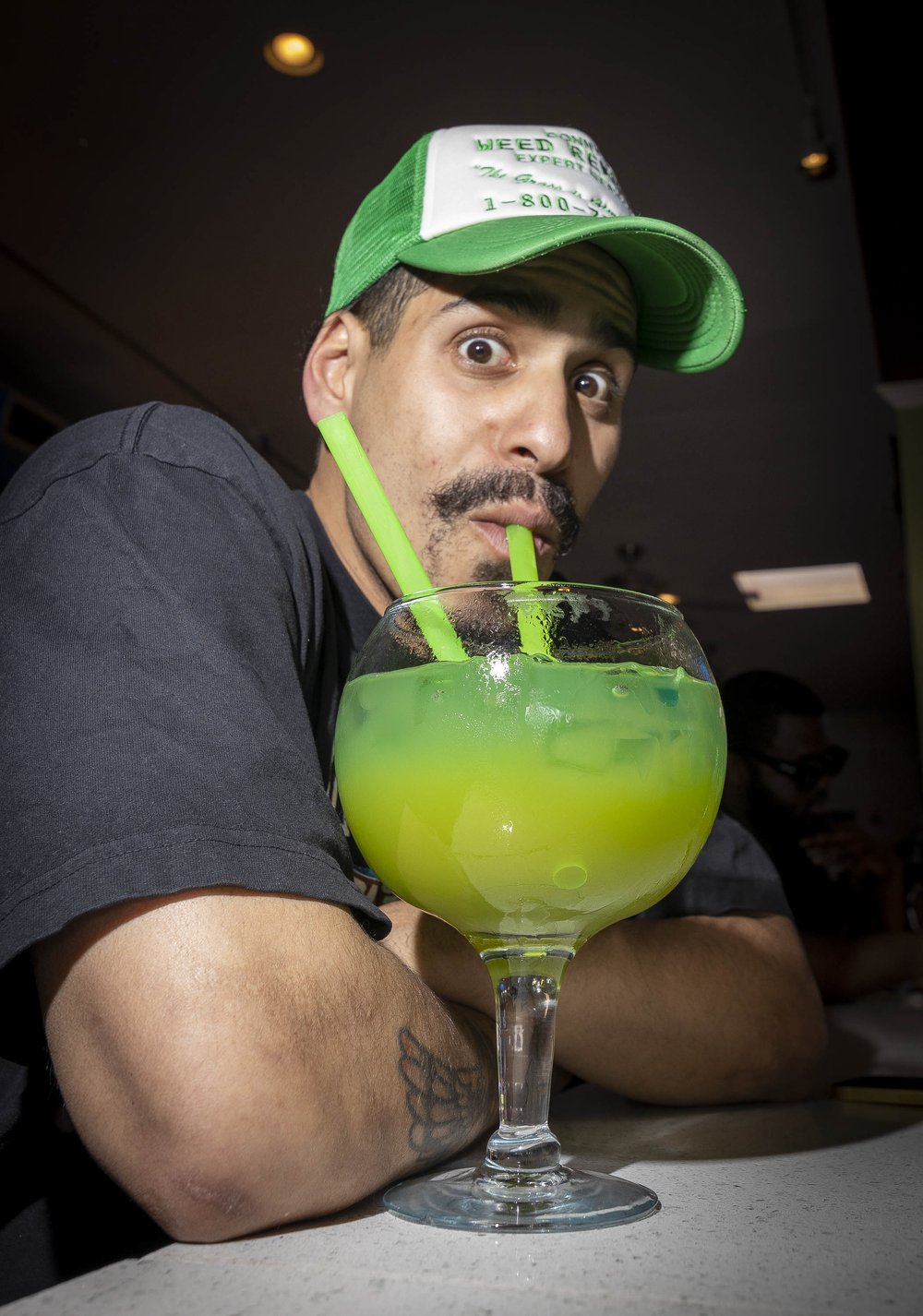Where to get great Puerto Rican food in the Bronx, from mofongo to famous lechón
June 8, 2023, 11:01 a.m.
Chef Farideh Sadeghin and Bronx native and skateboarder Pedro Muñoz explore Puerto Rican restaurants in the Bronx, home to the city's largest population of Puerto Ricans.

The steam table at 188 Cuchifritos in the Bronx.
Farideh Sadeghin is a chef and video host based in Brooklyn. As part of a new series, she explores New York City neighborhoods through their food and histories.

The 2012 Puerto Rican Day Parade.
The Bronx: home of Yankee Stadium and the Bronx Zoo, as well as the birthplace of Cardi B, but also home to the largest population of Puerto Ricans in all the five boroughs and some of the best cuchifritos, lechón, and mofongo in the city.
My friend, skater and fellow food fanatic Pedro Muñoz, joined me in exploring the borough's Puerto Rican food. His family initially moved from Puerto Rico to Manhattan before settling in the Bronx by the 1970s. Although Pedro is Puerto Rican and was born and raised in the Bronx, he says he didn’t grow up eating a ton of Puerto Rican food (aside from during the holidays) and never learned to speak Spanish. He’s what many might call a Nuyorican (an American-born Puerto Rican living in NYC that has lost touch with their island roots). At one time, this term was used pejoratively, but now many embrace the label and use it to celebrate their culture.

Pedro is one of the few people I know who can get down and eat everything like I can (he even has a show called Pedro Eats Everything), and since we were hitting up spots in the borough where he was born, raised and still lives, I knew he was the right person to eat with on this adventure.
Puerto Ricans first started arriving in the U.S., specifically New York, in the late 19th century after the Spanish-American War. In 1898, Spain ceded Puerto Rico as a territory to the U.S. under the Treaty of Paris, and in 1917, the Jones-Shafroth Act granted Puerto Ricans U.S. citizenship. Increased air travel in the 1950s contributed to the largest wave of Puerto Ricans moving to New York looking for opportunities and coming face to face with more hardships and discrimination, according to the Tenement Museum.
Like many cuisines, Puerto Rican food is characterized by the people who colonized the island and the people who migrated there. According to author Von Diaz and food historian Cruz Miguel Ortíz Cuadra, you’ll find plantains, which were brought to the Caribbean by slaves from Africa in the 16th century, used in numerous dishes, ranging from mofongo to pasteles. (Coconuts, meanwhile, came by way of Asia.) The presence of bacalao and pork in Puerto Rican cuisine are a result of Spanish colonization, while the heavy use of root vegetables (such as taro and cassava) are a result of the indigenous Taíno influence.
Puerto Rican cooking is often referred to as “Cocina Criolla,” meaning Creole cooking. While most Americans associate Creole food primarily with Louisiana, in the Spanish-speaking islands, criollo refers to Spanish Americans of European descent. Bold and vibrant flavors are often words used to characterize the food of Puerto Rico, and that was exactly what we were looking for — and found! — on our day eating around the Bronx.
We began our day with a couple of iced coquito lattes from Chocobar Cortes, a Caribbean outpost located on Alexander Avenue in the South Bronx. Chocobar Cortes is a fourth-generation, family-owned chocolate company that opened in mid-December 2021. The 93-year-old company was started in 1929 in the Dominican Republic by Don Pedro Cortés Forteza. Eventually, he moved to producing cacao in his native Puerto Rico as well.
Coquito (meaning “little coconut” in Spanish) is a coconut-based boozy beverage traditionally served around the holidays in Puerto Rico. We didn’t add any booze to our drinks, but the caffeine and sugar were enough to jumpstart our day.
We then popped over to La Isla Cuchifritos. I live in Bushwick, which has Brooklyn's largest population of Puerto Ricans, and there are a few La Isla locations within walking distance of my apartment. La Isla is where people go for takeout for dinner — you can feed your entire family and not break the bank.
Here you’ll find rice, beans, and your choice of meat, from rotisserie chicken to pork chops or roast pork, plus mofongo (fried smashed plantains), pasteles (pork and adobo stuffing encased in a green plantain masa and wrapped in banana leaves), sancocho (a traditional and hearty meat and veggie stew) and more.
We got a couple of pastelillos (meat-filled pastries, similar to empanadas) and alcapurrias (fritters made with taro and green plantains and stuffed with meat) and jugo de coco (coconut juice) before heading to Lechonera la Piraña.

Owner, operator, chef and machete wielder Angel Jimenez can come off as incredibly serious when you first approach Lechonera la Piraña, but once you enter his world inside the trailer and witness him interacting with customers while serving his famous lechón, he comes alive and is sublimely happy as he theatrically prepares his food.
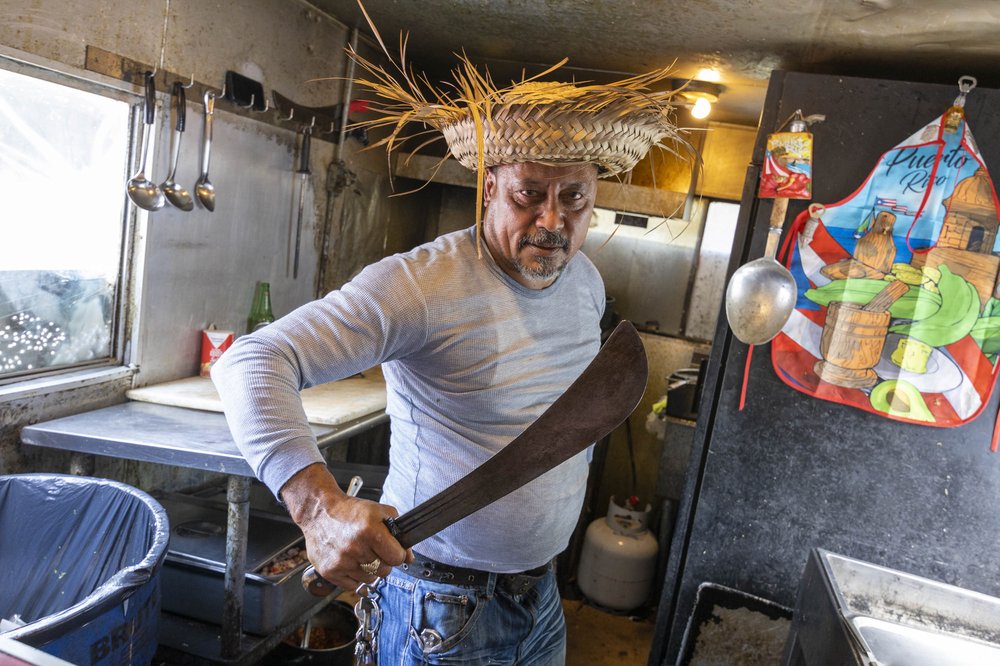
Before Jimenez moved to the Bronx, he grew up in Aquadilla, Puerto Rico. He said his dad started the lechonera in the 1980s, and Jimenez took over the business over 20 years ago. When people think of Puerto Rican food in the South Bronx, they usually think of Jimenez and his machete.
The trailer is parked at the corner of East 152nd Street and Wales Avenue and is only open on Saturday and Sunday. On the Sunday when we visited, we arrived just before noon. The lechonera wasn't due to open until 12:30 p.m., but a line had already formed and would continue to grow as the day went on. Parked next to Jimenez's trailer is his red vintage Chevrolet Impala. There’s a man milling about outside also selling pique (a Puerto Rican hot sauce made with whole peppers, vinegar, garlic, and herbs) in old liquor bottles.
Jimenez keeps his oven down the block on Wales Avenue, where he gleefully let me peek at the pigs that he’d popped in earlier that morning. The meat was golden, crisp and steaming, and as Jimenez grabbed a tray loaded with two huge slabs of pork and walked back to the trailer, the line of customers erupted joyfully, taking photos and videos.
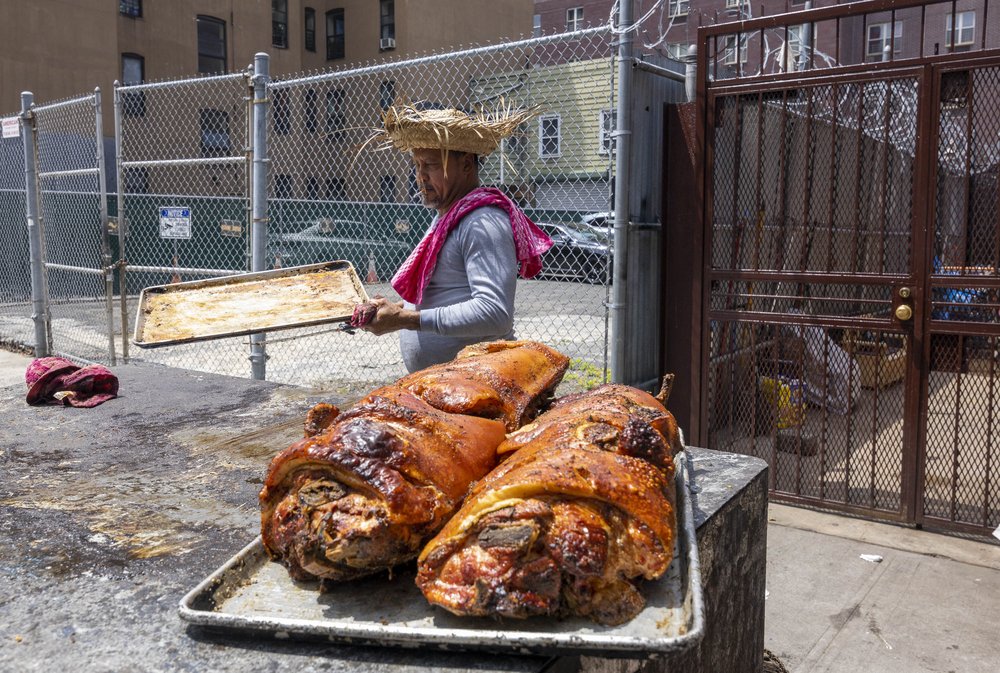
Once we’d made it inside the trailer to order, we got the lechón “con todos,” which included pulpo (octopus salad), mofongo, and arroz con gandules (rice with pigeon peas) all smothered in mojo de ajo, a bright garlic sauce. The lechón was crunchy, the octopus tender and the whole vibe was lit. I think we could have hung out there all day, but we moved on to 188 Bakery Cuchifritos.
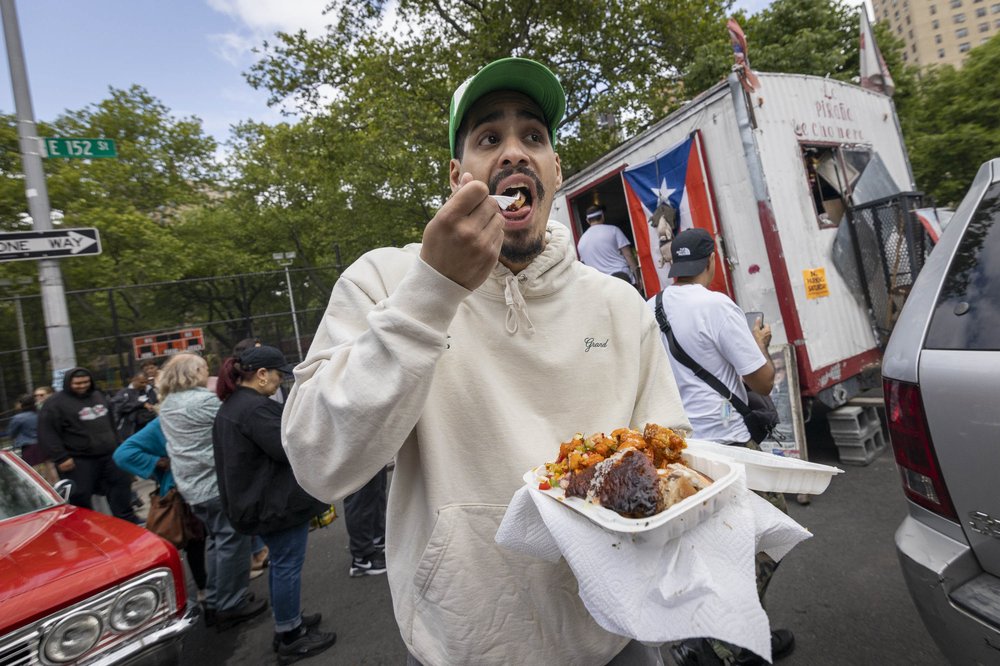
188 Bakery Cuchifritos, which opened in 1982, is another well-known spot located a bit further north in Fordham Heights. It was made even more popular when Anthony Bourdain went there for “Parts Unknown” in 2014. The menu lines the walls in the form of brightly-colored handwritten signs for each individual dish. Pedro hadn’t been to this location before, but had hit up their other spot on Westchester Avenue, where he always ordered empanadillas and jugo de coco.
We grabbed some seats on barstools at the formica countertop and ordered mofongo and pernil, as well as a couple of fruit juices. We doused both in more mojo de ajo before heading to our next location. One thing I regret not getting was the morcilla, or blood sausage. It looked so good, and I highly recommend trying it (I know that’s one thing I’ll be ordering next time, anyway!).
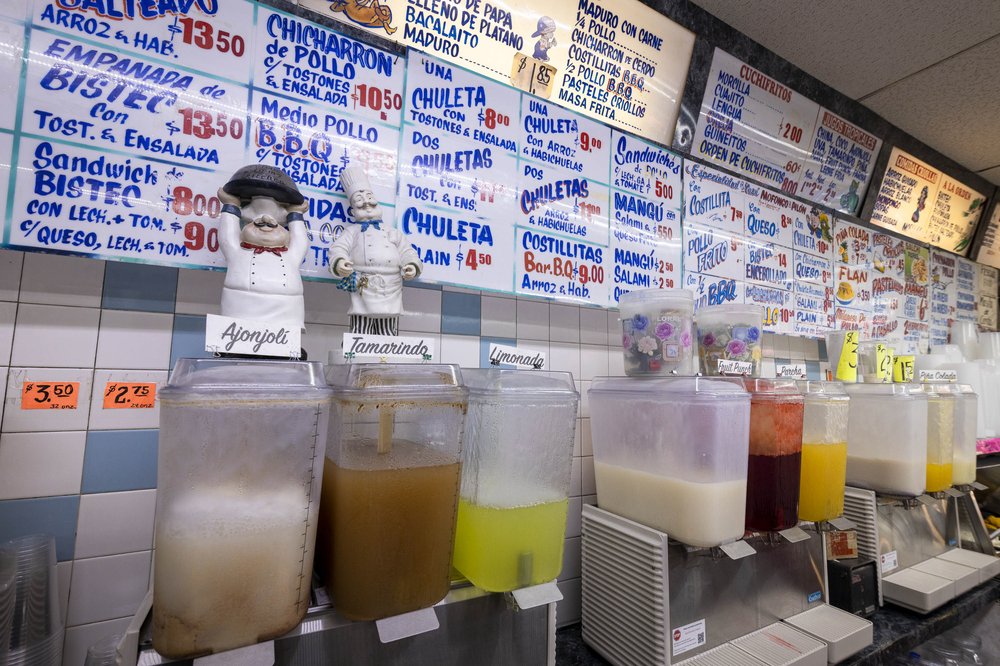
La Cocina Boricua, located in Castle Hill, was our fifth stop. The menu here is very traditional: We got a couple of drinks at the bar and a snack of arañitas. Arañitas, meaning “little spiders” in Spanish, are made from shredded and fried plantains and get their name because they kind of resemble little spiders due to their scraggliness. They’re pretty much the perfect bar snack, in my opinion, and go hand in hand with a refreshing beverage of some sort.
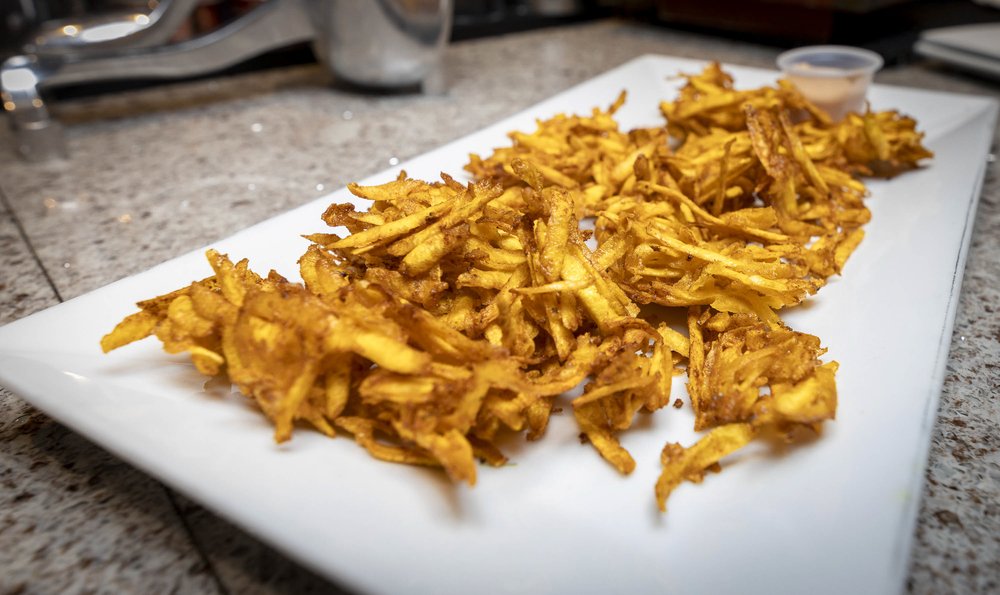
I really wanted to find someone selling piraguas (shaved ice smothered in fruit-flavored syrup, similar to a snow cone, but it’s a bit more pointy rather than rounded), but I think it maybe just wasn’t quite warm enough for it on the day we were out. The lady Pedro usually hits up wasn’t there, so we went on to our last spot: Made in Puerto Rico.
There are two Made in Puerto Rico locations: one in the South Bronx where we started our day, and the other not far from where we ended in East Tremont, near where Pedro was raised and still lives, so we popped inside that location. The menu highlights all of the Puerto Rican classics along with Made in Puerto Rico's many signature specialties.
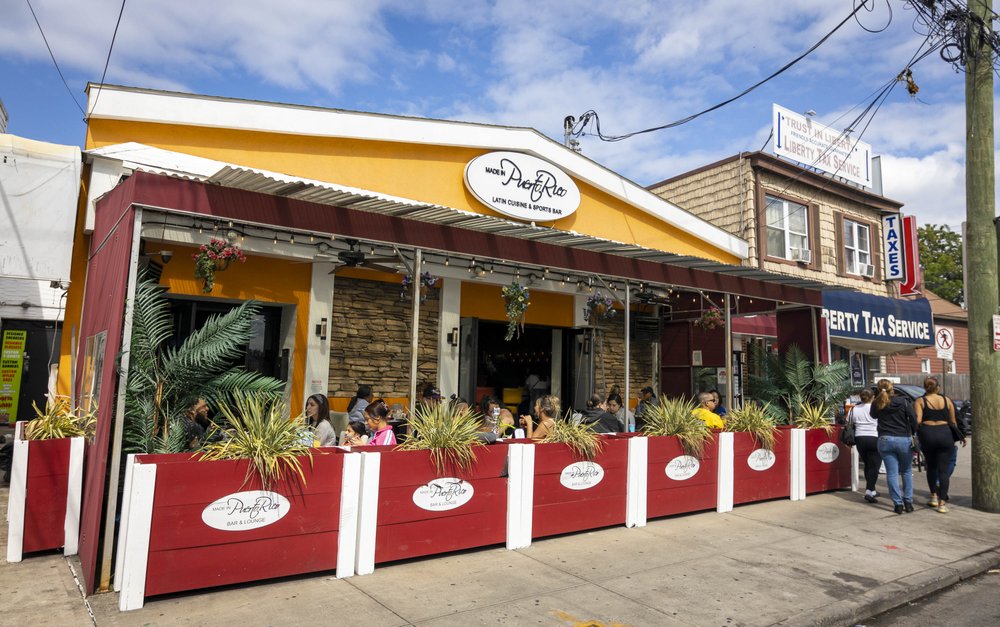
The trifongo, similar to mofongo, is a blend of pounded cassava and sweet and green plantains, topped with shrimp, steak, or chicken. The restaurant is also known for paella Puerto Rico and grilled meats, but we opted for a couple more drinks (I got the coquito martini, Pedro got an entire Sabor Tropical fish bowl for himself) and the Puerto Rican flan. The fish bowl was a blend of orange and vanilla vodka, spiced rum, and orange and pineapple juices with a rum floater — and it was VERY good (obviously I had a sip).
There’s only so much eating you can really do in one day, so we didn’t get to go to all of the spots on my list, like El Nuevo Bohio on East Tremont, known for its roast pork, or Con Sofrito on Commerce Avenue for empanadas, or homemade pastelillos from Margarita’s on Avenue St John. And I know I've gotta get back up to see Angel again for more of his famous lechón!
- heading
- There’s some lechón in your future!
- image
- image
- None
- caption
- body
All of the places mentioned in this story are in this Google Map, which you can save to your phone.
